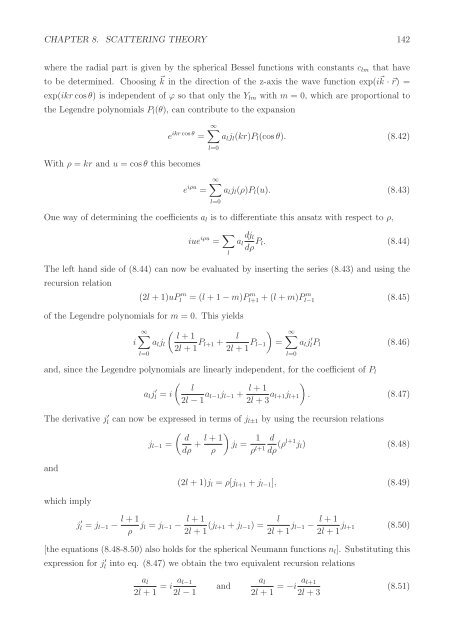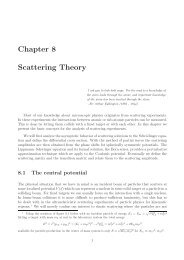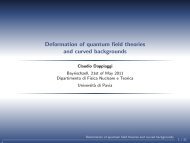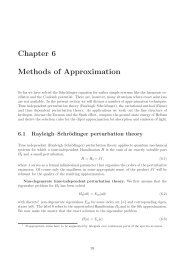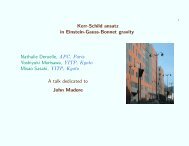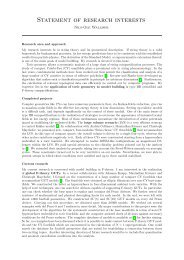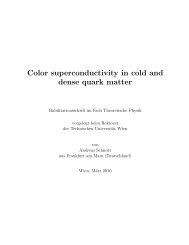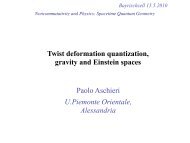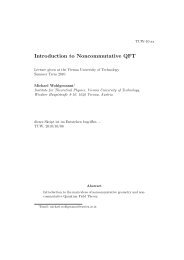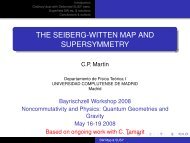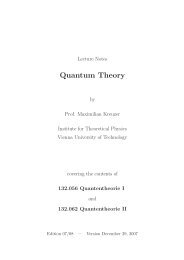Chapter 8 Scattering Theory - Particle Physics Group
Chapter 8 Scattering Theory - Particle Physics Group
Chapter 8 Scattering Theory - Particle Physics Group
Create successful ePaper yourself
Turn your PDF publications into a flip-book with our unique Google optimized e-Paper software.
CHAPTER 8. SCATTERING THEORY 142<br />
where the radial part is given by the spherical Bessel functions with constants c lm that have<br />
to be determined. Choosing ⃗ k in the direction of the z-axis the wave function exp(i ⃗ k · ⃗r) =<br />
exp(ikr cosθ) is independent of ϕ so that only the Y lm with m = 0, which are proportional to<br />
the Legendre polynomials P l (θ), can contribute to the expansion<br />
e ikr cos θ =<br />
∞∑<br />
a l j l (kr)P l (cos θ). (8.42)<br />
l=0<br />
With ρ = kr and u = cos θ this becomes<br />
e iρu =<br />
∞∑<br />
a l j l (ρ)P l (u). (8.43)<br />
l=0<br />
One way of determining the coefficients a l is to differentiate this ansatz with respect to ρ,<br />
iue iρu = ∑ l<br />
a l<br />
dj l<br />
dρ P l. (8.44)<br />
The left hand side of (8.44) can now be evaluated by inserting the series (8.43) and using the<br />
recursion relation<br />
(2l + 1)uP m<br />
l<br />
of the Legendre polynomials for m = 0. This yields<br />
i<br />
∞∑<br />
l=0<br />
= (l + 1 − m)P m<br />
l+1 + (l + m)P m<br />
l−1 (8.45)<br />
( l + 1<br />
a l j l<br />
2l + 1 P l+1 +<br />
l )<br />
2l + 1 P l−1 =<br />
∞∑<br />
a l j lP ′ l (8.46)<br />
and, since the Legendre polynomials are linearly independent, for the coefficient of P l<br />
( l<br />
a l j l ′ = i<br />
2l − 1 a l−1j l−1 + l + 1 )<br />
2l + 3 a l+1j l+1 . (8.47)<br />
The derivative j l ′ can now be expressed in terms of j l±1 by using the recursion relations<br />
( d<br />
j l−1 =<br />
dρ + l + 1 )<br />
j l = 1 d<br />
ρ ρ l+1 dρ (ρl+1 j l ) (8.48)<br />
l=0<br />
and<br />
(2l + 1)j l = ρ[j l+1 + j l−1 ], (8.49)<br />
which imply<br />
j ′ l = j l−1 − l + 1<br />
ρ j l = j l−1 − l + 1<br />
2l + 1 (j l+1 + j l−1 ) =<br />
l<br />
2l + 1 j l−1 − l + 1<br />
2l + 1 j l+1 (8.50)<br />
[the equations (8.48-8.50) also holds for the spherical Neumann functions n l ]. Substituting this<br />
expression for j ′ l<br />
into eq. (8.47) we obtain the two equivalent recursion relations<br />
a l<br />
2l + 1 = i a l−1<br />
2l − 1<br />
and<br />
a l<br />
2l + 1 = −i a l+1<br />
2l + 3<br />
(8.51)


